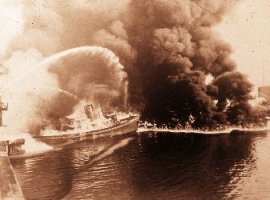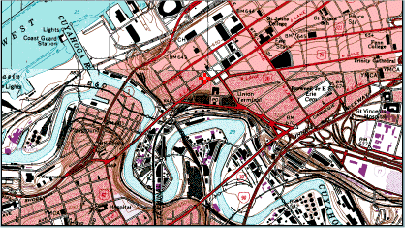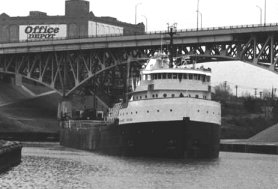The Ecotone wiki site is a collection of essays on "place" and its meaning to the writers. My other bursts of
place-idity:
Cemeteries
Coffeehouses
Coming & going
Food & place
Islands
Maps as place
Mythical place
Placenames
Rocks and place
Saving place
Sea
Spider
Trees
Visitors & place
The metropolis where I live, Cleveland, is defined by its river. That's sort of rare among cities, as I see it. Many great cities have rivers -- London, the Thames; Paris, the Seine; New York, the Hudson. St. Louis has the Mississippi, or the Missippi has St. Louis, and they come close to Cleveland; but if New Orleans were at the mouth of the Rio Grande, or if London ornamented the Severn, they would still be great cities, losing little of their character.
When people hear about the Cuyahoga, they invariably ask, "That's the one that caught fire, isn't it?"

Well, yes, it did. Thirty-five years ago, and quite a few times before that, the river, and sometimes railroad trestles and other structures, burned when oily waste from metal factories caught fire. In 1969, the environmental movement was getting under way, hapless Cleveland got a really nasty moment in the spotlight and the whole United States got started on a cleanup that continues to this day.

"Cuyahoga" is said to mean "crooked" in an Indian language, maybe Erie. Crooked it is -- the river's lower end meanders madly across its deep valley, The Flats, on a path that looks like a sink drain with several traps installed by a demented plumber. One of the continuing delights for visitors and residents alike is watching 600-foot ore carriers navigate 300-foot turns without hitting the steel bulkheads on the sides. The process is like maneuvering a screwdriver through a sink trap, and it's something to see, if you have the patience.
 The Flats, half industry and half entertain-ment, line the bulk-headed sides with vast piles of crushed limestone, dusty bulk-storage towers and refurbish brick buildings that boom with music at night. A decade ago, the Flats were busier; now some of the action has moved up the hill to an equally old district of refurbished warehouses, and some of it has moved out to the suburbs, most likely because of a spate of problems in the parking lots.
The Flats, half industry and half entertain-ment, line the bulk-headed sides with vast piles of crushed limestone, dusty bulk-storage towers and refurbish brick buildings that boom with music at night. A decade ago, the Flats were busier; now some of the action has moved up the hill to an equally old district of refurbished warehouses, and some of it has moved out to the suburbs, most likely because of a spate of problems in the parking lots.
The Cuyahoga also defines Cleveland by being a divider, as so many other rivers do. To the west were the Irish and German immigrant workers who built the Ohio and Erie canal and stayed to work in the growing factories as Cleveland became a steel town. To the east was the money that owned the ships and the factories. Then the East Side became the black side, with the whites on the west.
Now, with the blacks in the majority, the west has gathered the Hispanics and many of the Arabs; the east has Chinese and Africans and, in the suburbs, Russians. The synagogues and temples are east; the colleges and museums -- the work of old money -- are east; the huntn' fishn' snowmobilin' crowd are to the west. Because of the limitations of the roads, it takes serious time to get from one side to the other, and often folks don't go.
Oddly for a town where people claim never to cross the river, the Cuyahoga's northern end is a fiesta of bridges. Layers of bridges, like a giant's jungle gym -- wonderfully, the low ones swing and rise to make way for the ships. Another of the continuing delights of the river is watching from a high point while the bridges ponderously rise and fall; the slow-moving scene is accented by traffic and rapid-transit trains pouring gliding back and forth.
 The river doesn't go very far. It begins in marshes south and east of the city, wanders through Akron and finally plods up to its destination. Glaciers got it drunk on meltwater and left it confused, though not too confused to dig an impressive gorge through Akron.
The river doesn't go very far. It begins in marshes south and east of the city, wanders through Akron and finally plods up to its destination. Glaciers got it drunk on meltwater and left it confused, though not too confused to dig an impressive gorge through Akron.
Away out on the Cuyahoga's eastern end, I took my canoe and a friend for an experimental trip soon after I brought the boat to Cleveland. It had been my mother's, and had been stored for years under a cottage in New York state. Swatting mosquitos in a rural park, we lowered the boat into the murky water -- and watched in disappointment as it quickly filled and nearly sank before we got back to shore. That canoe is lovely, but it needs some refurbishing and a good soaking before anyone will paddle it with his knees dry.
As a definition, the river leaves a lot to be desired. It doesn't catch fire anymore. Its sides don't define the people, the people define the sides. The murky waters don't splash or gurgle. The fish they harbor aren't very attractive. But it's still alive and busy, and it's fun to watch.